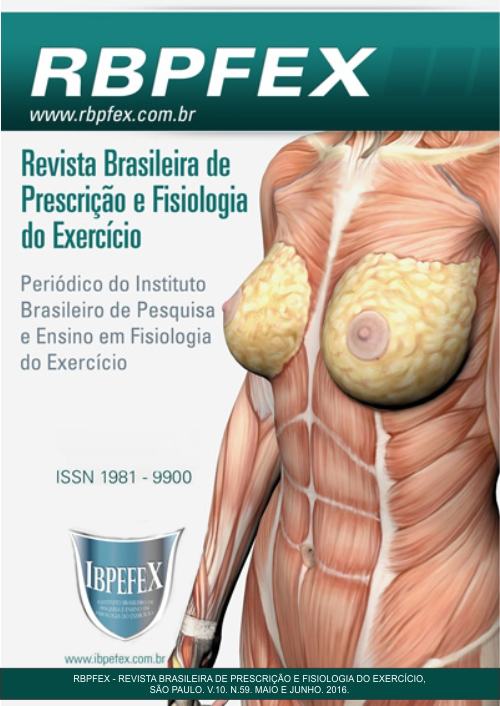Comparison of EMG of the brachial triceps and anterior deltoid in the shoulder development exercises and triceps bench press
Abstract
Electromyography (EMG) is used to highlight information relating to the state of activation of muscles measured by electrical activity of excitable membranes. The aim of the study was to compare the electromyographic activity of the triceps brachialmuscles and anterior deltoid in development exercises shoulder press and triceps bench press. The study included 10 male subjects aged greater than or equal to 18 years, bodybuilders for at least six months without injury, disease or recent surgeries. The test statistical model ANOVA two away was used to determine differences between the RMS values of each muscle and each year. The results of the study showed that the triceps muscle showed higher electromyographic activity in the triceps bench press (175.09μV) compared to shoulder development exercise (143.96μV), but these results did not show statistically significant differences. Compared to the previous deltoid,was foundmost electromyographic activity on the shoulder of development exercise (322.48μV) compared to triceps bench press (233.28μV), but these results did not show statistically significant differences.From these results can-We conclude that there were no significant differences in the electromyographic activity of the muscles evaluated in the exercises.
References
-Adami, G.F.; Ramberti, G.; Weiss. A Quality of life in obese subjects following biliopancreatic diversion. Behavior Medicine. Vol. 31. Num. 2. 2005. p. 53-60.
-Canavan, P.K. Reabilitação em medicina esportiva: um guia abrangente. São Paulo. Manole. 2001. p. 408.
-Clemons, J.M.; Aron. Effect of grip width on the myoelectric activity of the prime movers in the bench press. Journal of Strength and Condition Research. 1997. p. 82-87.
-Enoka, R.M. Bases neuromecânicas da cinesiologia. São Paulo. Manole. 2000.
-Graves, J.E.; Flanklin, B.A. Tratamento resistido na saúde e reabilitação. Rio de Janeiro. Revinter. 2006. p.440.
-Hermens, J.H.; Freriks, B.; Klug, C.D.; Rau, G. Development of recommendations for SEMG sensors and sensor placement procedures. Journalof Electromyogr. Kinesiol. 2000. p. 361-74.
-Heyward, V.H.; Stolarczyk, L.M. Avaliação da composição corporal aplicada. São Paulo. Manole. 2000. p. 73-98.
-Junior, V.A.R.; Gentil, P.; Oliveira, E.; Carmo, J. Comparação entre a atividade EMG do peitoral maior, deltóide anterior e tríceps braquial durante os exercícios supino reto e crucifixo. Revista Brasileira de Medicina do Esporte. Vol. 13. Num. 1. 2007.
-Kronbauer, G.A.; Binotto, M.A.; Eifert. D.; Chami, S.C.; Pohl, H.H. Ativação do músculo deltóide em exercícios de ombro. Coleção Pesquisa em Educação Física. Vol. 9. Num. 6. 2010.
-Leme, M.A.A. Estudo eletromiográfico dos músculos peitoral maior, deltóide e tríceps do braço em indivíduos treinados em musculação. São Paulo. 1999.
-Liberali, R. Metodologia Científica Prática: um saber fazer competente da saúde à educação. Florianópolis. 2008.
-Mcardle, W.D.; Katch, F.I.; Katch, V.L. Fisiologia do Exercício -Energia, Nutrição e Desempenho Humano. Guanabara Koogan. 2011.
-Mercer, J.A.; Bezodis, N.; Delion, D.; Zachry, T.; Rubley, M.D. EMG sensor location: Does it influence the ability to detect differences in muscle contraction conditions? J. Electromyogr. Kinesiol. 2006. p. 198-204.
-Oliveira, A.S.; Rodrigues, D.; Bérzin, F. Avaliação Eletromiográfica do Músculo Deltóide em Movimentos de Abdução do Ombro -Alterações Relacionadas ao Envelhecimento. Anais do Congresso Brasileiro de Biomecânica. Porto Alegre. Universidade Federal do Rio Grande do Sul. 2001
Authors who publish in this journal agree to the following terms:
- Authors retain the copyright and grant the journal the right of first publication, with work simultaneously licensed under the Creative Commons Attribution License BY-NC which allows the sharing of the work with acknowledgment of the authorship of the work and initial publication in this journal.
- Authors are authorized to enter into additional contracts separately for non-exclusive distribution of the version of the work published in this journal (eg, publishing in institutional repository or book chapter), with acknowledgment of authorship and initial publication in this journal.
- Authors are allowed and encouraged to post and distribute their work online (eg, in institutional repositories or on their personal page) at any point before or during the editorial process, as this can bring about productive change as well as increase impact and impact. citation of published work (See The Effect of Free Access).






